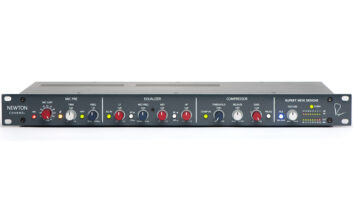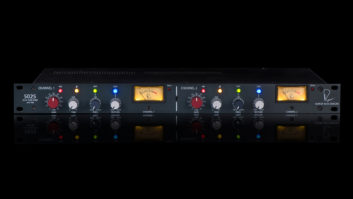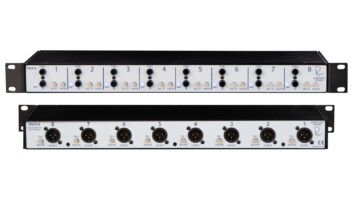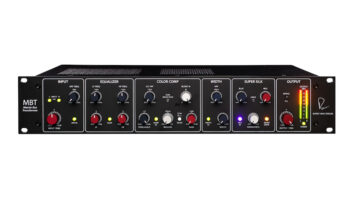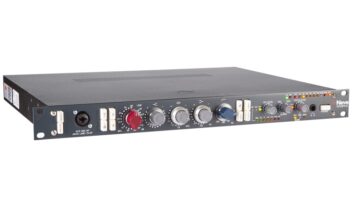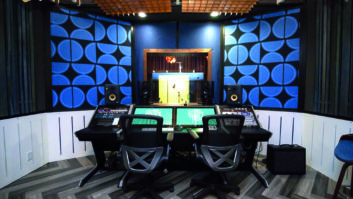The Portico II Channel by the one and only Mr. Rupert Neve simply sounds great — but of course, that should be a given. So please allow me to be a bit more helpful while I place this world-class product amongst some of its closest peers.
Here, I will base most comparisons and opinions on what I learned in evaluations for PAR’s “World-Class Channel Strips” Session Trial; that experience fully illuminated the abilities of such premium signal processors for me. As a complete “all-in-one” signal path, let’s look at the Portico II Channel from entrance to exit to grasp its capabilities.
Input Section
The Portico II starts with three transformer-coupled inputs, one for mics with 72 dB of gain (66 dB in 6 dB steps with an additional 6 dB on the +/- 6 dB gain trim). Wisely, this gain trim applies to the mic and DI inputs as well, offering a convenient gain rider. The line-level input makes the Portico II quite useful as a channel insert and would be excellent for stereo sources with a second unit and the stereo link jacks on the rear panel. The DI input sounds particularly sweet to me, as its transformer imparts fullness and body not seen in budget units and the thru jack is equally welcome.

The mic input sounds particularly sweet and silky — neither fat, nor mid-forward, nor bright — just open and classy while exhibiting lots of headroom. The +/- 36 V power supply rails (higher than normal) in this circuit likely contribute to this headroom, preventing the front end from sounding like a crunchable 1073 vintage Neve mic pre. I tried acoustic guitars, electric guitars, vocals, basses and percussion always with neutral, yet polished results.
High-Pass Filter
This filter is continuously variable from 20 to 250 Hz at -12 dB/octave and is clean, exhibiting no audible distortion or resonance at the filter point. This circuit is particularly useful in that you can filter the program signal or the side-chain going to the compressor for less pumping with bassy sources.
EQ Section
The EQ controls of the Portico II offer best-of-class flexibility and more so; this EQ delivers the transparency, sweetness and purity of tone you’d expect. The low and high bands offer four stepped frequency choices each (35, 60, 100, 220 and 4.7, 6.8, 12, 25K, respectively), +/- 15 dB of gain and either bell or shelf curves. The two mid bands are more interesting and complicated with continuously variable frequency and Q, as well as +/- 15 dB of range. The frequency ranges generously overlap the low (70-1,400) and high (700-14K) bands and the Q reaches a nicely shallow 0.7 up to a fairly steep value of 5.
The de-esser is a fully functional, variable and controllable feature, not a stripped down afterthought; it uses the HMF band to select frequency, Q to control the bandwidth (nice!) and the HMF EQ level control is still functional for the actual EQing of that same band! In the aforementioned PAR Session Trial, the Manley Voxbox and the Millennia-Media STT-1 had excellent deessers too, but the Portico II’s may be just be the best I’ve ever used.
Compressor Limiter Section
As much praise as the EQ section of this unit has garnered here, I still think the Portico II’s biggest draw is its eminently flexible compressor. The only similarly versatile compressor I have used on such a channel strip is found on the API 7600, but it sounds quite different from this Portico — not better or worse, just different.
Both feedback and feed-forward modes are offered (plus RMS or peak detection), giving distinctly different behaviors and tones: the feed-forward for quickness, hardness and accuracy and the feedback for slowness, musicality and “vintage-ness.” But the big rewards lie with the blend control, allowing accurate variable blending of compressed and unprocessed signals — parallel compression. I could go on for days about the greatness of this feature: for example, some heavy compression gently tucked under for perky peaks and thick density, aggressive feed-forward attenuation heavily blended in for superb clarity and “in your face-ness,” 100 percent compressed feedback for a familiar flavor from yesteryear, not to mention the side-chain HPF interactions. All that, and more, is available in this one feature.
Texture
So you want some vintage Neve flavor in your rack, but modern sonics, too? Then you’re largely covered by the Portico II’s Texture options. With Silk engaged, you can control negative feedback to the output transformer, add harmonics and affect frequency response — from barely even apparent to rather flavorful. Silk is rather dark when cranked, with increased low-end hang time and obvious distortion; at about one o’clock, it gets interesting and by four o’clock, your bass guitar is so growly, fat, thick and chewy that you’ll be head bobbing! Silk+ is actually less apparent when cranked, adding some subtle character and density without sacrificing high end or detail. You can use liberal amounts of Silk+ on vocals or even mixes. This is not an “all or nothing” mangling proposition —moderate Texture amounts leave your signal unharmed and only “added to,” not destroyed. This feature was like the wonderful transformer-loading option of the Great River ME-1NV/EQ-1NV (used in the aforementioned PAR Session Trial), but with variable control offers more “extremism,” for lack of a better word.
Summary
Considering the fact that all sections of the Portico II are eminently useful, if not best in class, it’s hard to not like this unit, even at its premium price point ($3,195 street). “It’s hard not to love it” is a more accurate statement. The EQ in general, the de-esser, the superb compressor and the Silk features will surprise you and demand daily usage. I only have a few quibbles: A master output level would be nice to have, the switches don’t feel as good as the pots do and some additional metering wouldn’t hurt, either, but these points are incredibly minor in context, as in the context of world-class channel strips, of which the Portico II Channel is one of the very finest available.
Price: $3,495 list
Contact: Rupert Neve Designs | rupertneve.com
Rob Tavaglione owns and operates Catalyst Recording in Charlotte, NC.
